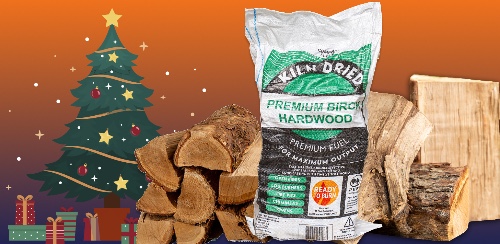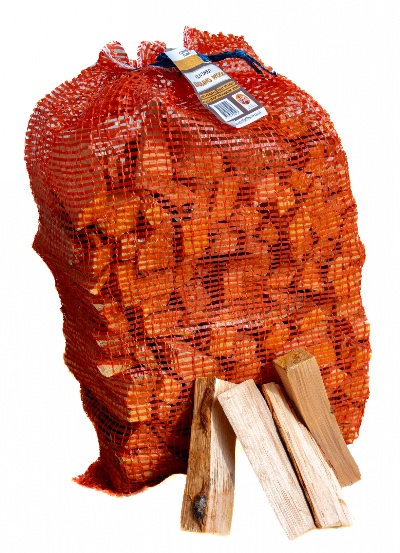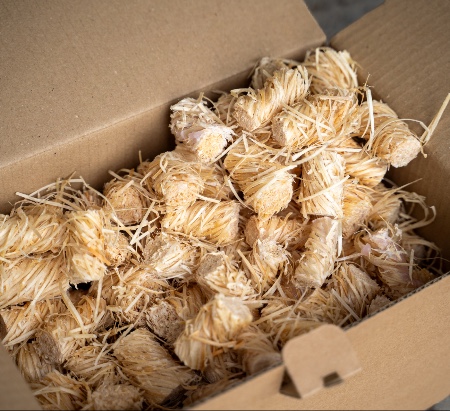How much wood do you need to burn through winter?
Lots of our customers use their wood burners in the evenings and weekends, they do not use it as their primary heat source, however, the wood burner helps towards reducing your heating costs considerably.
If you use your wood burner in the evenings you are looking at burning approximately 2 to 3 cubic meters of kiln dried firewood per year.
If you use your wood burner evenings and weekends you will require approximately 4 cubic meters of kiln dried wood per year.
If you use your wood burner during the day, evenings and weekends you will require approximately 6 to 7 cubic meters of kiln dried logs per year.
Kiln dried firewood vs seasoned firewood
When you purchase firewood you have a choice between kiln dried firewood and seasoned firewood. Seasoned firewood will have a much higher water content which means it will burn at a lower temperature, be harder to light and ultimately give out much less energy. Therefore, you can expect to put many more logs onto your log burner or open fire and therefore you’ll need more of them.
If you burn unseasoned wood, the efficiency drops even further.
For maximum efficiency, always burn ‘ready to burn’ kiln dried firewood. They always burn hotter and give out more energy.
Calorific values of different hardwoods
How much firewood you need will also depend on what species of tree you choose to burn on your wood stove.
Burning different types of kiln dried hardwoods makes a big difference to the calorific value:
Kiln dried Alder has a calorific value 4.5kw per kilo of wood
Kiln dried Birch has a calorific value 4.6 kw per kilo of wood
Kiln dried Ash has a calorific value 4.9 to 5 kw per kilo of wood
Kiln dried Oak has a calorific value 5.35kw per kilo of wood
These calculations were made by burning 1 Good size log and measuring the heat output over 1 hour. As you can see, the oak wood is the most energy dense wood you can burn.
Alder is easy to light and gives off 4.5kw of heat quickly, from a 1kg log, the downside is they burn quickly, if you are looking for a quick fire when you come home from work, and to give instant heat, the Kiln Dried Alder is great.
Birch, is still easy to light, gives off 4.6kw of heat from a single 1kg Kiln Dried Log, the bark comes off easily and can be used as the fire lighter, the smell is amazing when being burnt, this is a denser wood so will burn for a longer period of time, Kiln Dried Birch is most popular wood, customers give very good remarks.
Ash This is a more dense wood, slightly harder to light but gives off an amazing 4.9 to 5 kw per hour, using a 1 kg log, Ash has been used for firewood for many centuries, it’s an amazing wood and highly recommended. Very nice smell when the log is burning.
Oak, the hardest of our Kiln Dried wood, it’s an extremely dense wood, a bit harder to light when starting the fire, then it’s easy to put 1 log on every 1 ½ hours, it gives off an amazing 5.35kw of heat per hour from a 1kg Kiln Dried Oak log, Oak is outstanding, 1 log every 1 ½ hours, it costs are slightly higher, but the amount of wood required is less than any other wood we sell, highly recommended for the more experienced person.
How many logs are there in 1 cubic metre?
The number of logs in 1 cubic metre of kiln-dried firewood depends on several factors:
- Log size: Typically, firewood is cut to 25 cm (10 inches), 30 cm (12 inches), or other standard lengths.
- Log diameter: Thicker logs will take up more space, reducing the total count.
- Stacking method: Whether the wood is neatly stacked or loosely piled significantly affects the number.
- Type of wood: Some woods are denser than others, impacting the size and count of the logs.
As a general estimate:
- Small: Around 300–400 in 1 cubic metre.
- Medium: Around 200–300 .
- Large: Around 150–200 .
The way we stack firewood here, you can expect approximately 300 individual logs per cubic metre.
How much firewood do I need calculator
To calculate more accurately how much firewood you might need we can use a simple calculation.
If we can establish roughly how long you use your solid fuel burner each day we can then use this to establish how many pieces of wood you will burn and what the kw output will be.
We can then attempt to establish the cost per kw of heat energy output.
| Ash | Birch | Alder | Oak | |
| Per Log | 5kw | 4.6kw | 4.5kw | 5.35kw |
| 1 Cubic Meter | 1500kw | 1380kw | 1350kw | 1605kw |
Kiln Dried Hardwood KW cost
This table shows the cost per kw of heat energy for each of the kiln dried hardwood species we sell. Oak provides the best value for money at 16.4 pence per kw.
| Cost | Ash | Birch | Alder | Oak |
| 1 Cubic Meter | £265.67 | £241.91 | £240.83 | £265.67 |
| Per Log | £0.89 | £0.80 | £0.80 | £0.88 |
| KW Output | 5kw | 4.6kw | 4.5kw | 5.35kw |
| Cost Per KW | £0.178 | £0.174 | £0.177 | £0.164 |
These prices are based on buying 1 cubic metre of wood. Further savings can be made buy buying up to 4 cubic metres of wood at once which reduces the cost per meter and therefore the kw cost too.
Calculating how much wood you need and what it costs
Now we know the kw output of the wood, and the relative cost, let’s consider how many you might want to burn to stay warm.
A very common scenario is that you come home from work and light your fire at 5pm. You go to bed around 10pm so have your fire lit for 5 hours.
Each log outputs enough energy to stay warm for about an hour so we can roughly work out that you will burn 1 log per hour. However, being realistic you might burn more than that if you want a roaring fire or want to stay particularly toasty warm.
So let’s say you want to burn 7 logs per evening outputting around 35kw of heat.
1 cubic meter contains approximately 300 logs which means you could light your fire approximately 42 times.
If you start lighting your fire on the 1st of November and continue doing so until the end of March there are 151 days. That equates to around 3.6 cubic metres of wood.
The best value way to buy wood is therefore to order 4 cubic metres of wood in one go which gives you a bit extra for weekends, Christmas Day and so on.
This table shows a calculation of how much a winter of running your wood stove is likely to cost if you buy 4 cubic metres of wood in November and burn it through to the end of March.
| Cost | Ash | Birch | Alder | Oak |
| 4 Cubic Meters | £933.08 | £838.04 | £833.72 | £933.08 |
| Per Cubic Meter | £233.27 | £209.51 | £208.43 | £233.27 |
| Per Day | £6.18 | £5.55 | £5.52 | £6.18 |
| KW Heat Output | ~ 6000 | ~ 5520 | ~ 5400 | ~ 6420 |
| Cost per KW | £0.155 | £0.152 | £0.154 | £0.145 |
A Note on Burn Rate
As you can see from the figures above, different woods gives different heat out puts and burn times, we have measured this in KW per hour and per kilo of wood, and average log weighs approximately 1 kg,
Kiln Dried Oak is the best log to burn if you need heat output, it’s also the slowest burner, so you get much more heat from a Kiln Dried Oak Wood as it burns longer and hotter, it’s also the most dense wood, so lighting it is slightly harder to do.
Use a modern, efficient wood burning stove
The pictures below show you the efficiency of a modern wood burning stove and the result of burning Kiln Dried Wood, this is our own stove which we use to heat our offices, the stove is also used to test all the products we sell, the stove is 6 years old.

First picture shows the size of the log, the log is Alder.

The second image shows you the log catching fire shortly after it has been added to the stove.

The final image shows you the log alight, this log weighed 1kg, so we only required 1 x log, it produced 4.5kw of heat for 1 hour.
This means in a normal evening burning from 6pm to 10pm you need approximately 5 to 6 x 1kg of Kiln Dried wood, that’s how efficient burning Kiln Dried wood can be.
These results were produced on our own fairly modern energy efficient wood burning stove, obviously different stoves will vary in the burn rate, the most important thing is the air control, you really need to have a good quality air supply, also, ensure the stove is serviced every year with the flue being swept.
Measuring moisture content in wood
All of our calculations here are based on burning very dry wood with very low moisture content. This can only really be achieved by buying kiln dried wood. But, regardless of where you buy your firewood, if it is stored incorrectly, it could re-absorb moisture and become less efficient to burn over time.
To store your wood correctly, refer to our article ‘how to store your firewood‘.
If you are concerned about achieving maximum efficiency then keeping an eye on the moisture content of the wood you are burning is essential.
To measuring the moisture content you can use a moisture meter to take readings. Readings should be taken from different parts of the log in order to calculate an average.
How to measure moisture in wood
Select different wood, from the top of the pile, the side of the pile, the bottom and end and the middle of the stack. Different positions will give different readings, the bottom will normally give the highest reading as it has not got the air circulation, the top is normally the dryest as it has plenty of air.
It is then advisable to split the log in half using an axe, the most important reading should be taken from inside the log, if for instance the outside is reading 8% the inside might read 16%, the inside of the log is the most difficult to dry, Kiln Dried Wood dry from the inside out, all of our firewood is tested before leaving us.
Should the log be wet, it is advisable to wipe any excess moisture away with a rag before taking the measurement, it is NOT recommended to burn wet wood.
Once you have split the wood, take the moisture readings from the centre of the log, push the pins of the moisture meter into the log, then take the reading
We recommend a maximum of 18% moisture, any wetter the log might smoulder and give off harmful fumes, we only recommend using Kiln Dried Wood, all ours firewood has a moisture reading of below 18% when we deliver it to you.
Once you have taken your readings and worked out the average moisture content, you can go ahead and burn your wood. If any of your wood has a reading above 18%, put it back and let it dry out.
Some moisture meters are sensitive to the chemicals inside the log you may be asked by the meter to enter what type of wood you are testing, this is normally found on better quality meters.
Over time and after many uses the moisture meter pins may need replacing, with certain meters you get a set of new pins, they are very easy to fit, the sharper the pins the deeper you can push the meter into the log, deeper gives you a better result, you are always looking to get to the centre of the log to get the best results
Comparison between Kiln Dried Firewoodand Seasoned Firewood
Obviously seasoned wood is much cheaper to buy initially compared to Kiln Dried wood.
The difference is easy to tell: seasoned wood will be heavier, this is because it has a higher water content inside the log if they are not seasoned properly and have a higher water content.
This will effect burning and the heat output. Poorly seasoned log will smoulder or have very small flames, the glass on your stove will go black quickly, and the flue will be damaged.
Compare the burning, you need 4 times as much poorly seasoned wood as you do to Kiln Dried wood.
If you burn 1 kiln dried log you will need 4 seasoned logs to give you the same heat output, the mathematics will be easy to see.
We use a wood burner at Logans Logs every day during the winter, we only ever burn 1 Kiln Dried Log at a time, it is enough to heat an room area of 65ft by 20ft, the average temperature inside our office is always 25 degrees to 30 degrees, the economy is easy to see, you can see the picture above of our stove burning 1 log at a time.
Lighting your fire
Lighting a Fire using Kiln Dried wood could not be simpler, first make sure the ash tray is empty, make sure the hearth is clean and finally a quick visual check of the entire fire to make sure there is no broken glass or anything has fallen off.
Then using Kiln Dried Kindling put approximately 10 pieces into the hearth, crossing them in opposite directions to each other, so it looks like the picture below.
Using 1 to 2 of our wax fire lighters place them on top of the pile of kindling and light them, close the door and open the air vents up, once the pile of kindling is alight, then put on 1 to 2 kiln dried logs on top.
Turn the air supply down but don’t close it completely. We are looking for a reduced air flow. Now the fire is lit, you should with proper air control burn approximately 1 log an hour, but air control is vital to archive these results.

Difference between Kiln Dried Softwood and Hardwood
Softwood is mainly a from of Spruce/Conifer trees, its fast growing, you can plant a forest of softwood saplings and within 30 to 40 years be harvesting it, either for building timber or firewood.
Softwoods come from trees, such as conifer or Spruce they are evergreen trees. These trees have needle like leaves that usually remain green year around, as opposed to hardwood trees that have broad leaves that drop off every year.
Softwoods grow faster than hardwoods, usually taking around 30 to 40 years before being ready to harvest. These fast-growing trees tends to make them much less dense than hardwood trees. Planting softwood trees is very simple, it’s the perfect replaceable fuel supply, every tree that is cut for Logans Logs is replaced by 4 saplings, ensuring the future supply never runs out.
The big advantage with Kiln Dried Softwood is it is easy to light and gives an immediate heat output, they are superb when you get home from work and only want a few hours burning time.

Hardwoods come from trees classified as broad leaf, they drop their leaves every year, the trees are normally Oak, Birch, Alder, Ash and Maple.
Hardwood trees are mostly known as deciduous, having broad leaves that change colour and fall off in the autumn and winter each year, the leaves have fine veins running through them.
Hardwood is much denser than softwood, the wood is much heavier because it is so dense, because of the density, it makes the perfect wood for log burning along with furniture, planting and harvesting a hardwood forest can take up to 150 years to grow and be ready for harvesting, every hardwood tree felled for Logans Logs, 10 are planted, this ensures the future for everyone.
Hardwood is far better than softwood, purely down to the wood density. The denser the log the longer and hotter it will burn, you need 1 hardwood kiln dried log to give you approximately 1 ½ hours burning time, Kiln Dried Softwood you will need 3 to 4 over the same period.






